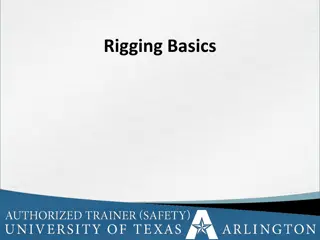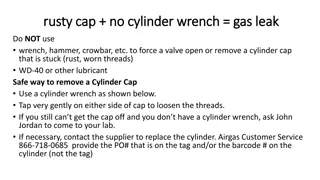Overview of Adjustable Wrench and Pipe Wrench Usage and Hazards
Adjustable wrenches and pipe wrenches are essential tools for tightening and loosening bolts, nuts, and pipes. The adjustable wrench, also known as the crescent wrench, provides flexibility in fitting various objects. Pipe wrenches are specifically designed for soft iron pipes and fittings. However, using these wrenches comes with hazards like struck-bys and pinching, which can lead to severe injuries or even fatalities. Understanding the history, usage, and risks associated with these tools is crucial for safe operation.
Download Presentation

Please find below an Image/Link to download the presentation.
The content on the website is provided AS IS for your information and personal use only. It may not be sold, licensed, or shared on other websites without obtaining consent from the author.If you encounter any issues during the download, it is possible that the publisher has removed the file from their server.
You are allowed to download the files provided on this website for personal or commercial use, subject to the condition that they are used lawfully. All files are the property of their respective owners.
The content on the website is provided AS IS for your information and personal use only. It may not be sold, licensed, or shared on other websites without obtaining consent from the author.
E N D
Presentation Transcript
Adjustable Wrench & Pipe Wrench
Adjustable Wrench An adjustable wrench is a tool that is usually operated by hand, and is made for tightening or loosening bolts, nuts, or anything that needs a turn. This wrench works as a lever and there are notches at the mouth for gripping. The wrench is pulled at a right angle to the axis of the lever action and the bolt or nut. Some wrenches have mouths that can be tightened to better fit various objects that need turning. The adjustable wrench is also called the crescent wrench. Site: About.com - http://inventors.about.com/library/inventors/blwrench.htm
Pipe Wrench The pipe wrench is used for turning soft iron pipes and fittings with a rounded surface. The design of the adjustable jaws allows it to lock in the frame, such that any forward pressure on the handle tends to pull the jaws tighter together. Teeth (angled in the direction of the turn) dig into the soft pipe. They are not intended for use on hard hex nuts because they would ruin the head; however when a hex nut becomes rounded beyond use with standard wrenches, the pipe wrench is sometimes used to break the bolt or nut free. Site: http://en.wikipedia.org/wiki/Pipe_wrench
Wrench History Solymon Merrick patented the first wrench in 1835. Subsequently, a separate patent for a wrench was granted to Daniel C. Stillson, a steamboat fireman. Stillson suggested to the heating and piping firm Walworth that they develop a design for a wrench that could be used for screwing pipes together. Previously, serrated blacksmith tongs had been used for that purpose. The owner James Walworth told Stillson to make a prototype and either twist off the pipe or break the wrench. Stillson s prototype twisted the pipe successfully. His design was then patented and Walworth manufactured the wrench. Site: About.com - http://inventors.about.com/library/inventors/blwrench.htm
Typical Hazards Wrench Struck-By s: The main hazard of using a pipe or adjustable wrench occurs when it loses its grip, slips off and strikes the worker (usually when pulling on the wrench). Pinching: Another hazard occurs when the item being gripped breaks or when the wrench slips resulting in finger injuries, hand trauma and damage to the wrench itself (usually when pushing on the wrench). These dangers increase in limited access areas
Fatalities -There were seven fatalities investigated by OSHA from 1990 thru 2009 that involved wrenches -The majority of these fatalities are from struck-by- accidents. However, there is always danger of pinching. Site: Source: Extracted from OSHA Accident Investigation Data 1990-2009
Fatality Example A worker was assisting in servicing a duplex mud pump. He was struck by a 36-in. pipe wrench, situated on the rotating shaft of the diesel engine, when the clutch was engaged. Worker was killed. At the time of the accident, the engine was running. Source: Extracted from OSHA Accident Investigation Data 1990-2009
Fatality Example A worker, the lead man, was working from a stepladder preparing to remove an industrial roll-up steel overhead door that was stuck in the lowered position. The worker was holding a pipe wrench on the end of the shaft and instructed another worker who was on the opposite side of the stepladder to loosen a bolt. As the bolt was loosened, the tension on the spring caused the shaft to turn and the wrench struck the lead man in the head and he fell from the ladder striking the concrete floor. He died as a result of his injuries. Source: Extracted from OSHA Accident Investigation Data 1990-2009
Fatality Example A worker was using a pipe wrench with a cheater bar to turn the steering rod on an earth-boring machine. He was being assisted by a coworker with a second wrench to obtain the necessary torque. One of the two men lost his grip on his wrench, causing the steering rod to turn back suddenly. The worker's wrench was still attached to the steering rod, and the wrench and cheater bar struck him in the back of the head. He died as a result of his injuries. Source: Extracted from OSHA Accident Investigation Data 1990-2009
Fatality Example A directional drilling machine was being used to bore a 130-foot-long borehole to be used for a water line. At the time of the accident, the end pipe section was being added to the water pipe by two workers using a pipe wrench. The pipe wrench spun out of control and both employees were struck in the head. One worker was killed and the other was injured. Source: Extracted from OSHA Accident Investigation Data 1990-2009
Fatality Example A worker was removing a 12-foot pipe stem from a horizontal drill pipe. The worker used a 60-inch pipe wrench on the connection to hold the pipe stem in place. The jobsite foreman released his end and the worker stepped up to the pipe to remove the pipe wrench when, for undetermined reasons, the pipe rotated. The pipe wrench that was still attached to the pipe struck the worker in the head and killed him. Source: Extracted from OSHA Accident Investigation Data 1990-2009
Fatality Example A worker was attempting to loosen a boring rod from a cable boring machine when the rod rotated, causing the pipe wrench attached to the rod to spin around. The wrench handle struck the worker in the head, killing him. Source: Extracted from OSHA Accident Investigation Data 1990-2009
Fatality Example A worker used a 4 ft pipe wrench to remove the starter rod from the end of the boring rods. As he put the wrench on the 2 1/4 in. diameter bore rod, the boring machine operator started turning the bore rods. This caused the wrench to spin around, striking worker on the top of his head. He was killed. Source: Extracted from OSHA Accident Investigation Data 1990-2009
OSHA Regulation Pipe Wrenches are addressed in the OSHA Regulations 29 CFR 1926 OSHA Construction Regulations Subpart I Tools Hand and Power Section 1926.301 Part B Wrenches, including adjustable, pipe, end, and socket wrenches shall not be used when jaws are sprung to the point that slippage occurs.
Required PPE Workers should always wear: - Goggles or other protective eyewear - Gloves / insulated gloves - Safety shoes, typical work boots - Hard hat
Safety Procedures - Before each use, inspect each wrench for worn gripping teeth and / or a loose mechanism. Inspect periodically for worn or unsafe parts and replace them (e.g., check for worn threads on the adjustment ring and movable jaw) - Select a pipe wrench with sufficient capacity and leverage to do the job (do not use a cheater bar) - Use a pipe wrench to turn or hold a pipe. Never use a pipe wrench to bend, raise or lift a pipe. Site: http://www.ccohs.ca/oshanswers/safety_haz/hand_tools/pipetools.html
Safety Procedures Adjust the pipe wrench grip to maintain a gap between the back of the hook jaw and the pipe. This concentrates the pressure at the jaw teeth, producing the maximum gripping force. It also aids the ratcheting action. Keep pipe wrench teeth clean and sharp Face a pipe wrench forward. Turn wrench so pressure is against the heel jaw Site: http://www.ccohs.ca/oshanswers/safety_haz/hand_tools/pipetools.html
Safety Procedures The best practice is to pull the wrench across the body while maintaining a wide stance. Pulling and pushing on the pipe wrench handle can lead to off balance dangers. Whatever the physical endeavor or tool, maintain a proper stance with feet firmly placed to maintain balance. Site: http://www.ccohs.ca/oshanswers/safety_haz/hand_tools/pipetools.html
Think Safety Work Safely























